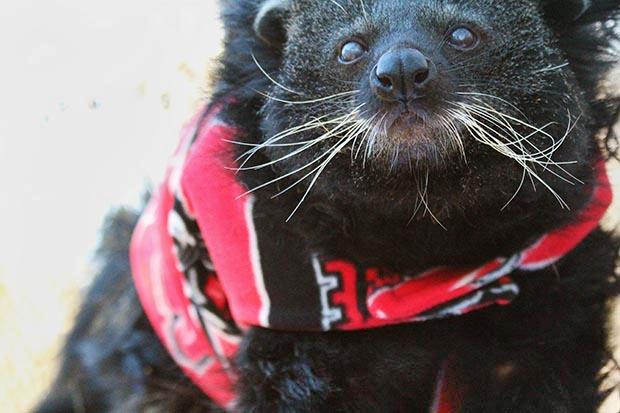N.C. State’s carnivore team, a group of first through third year veterinary students, is working to rehabilitate a binturong, a species of mammals from Southeast Asia commonly called “bearcats.”
Lobo, a binturong, who is currently in the care of the Conservators’ Center in Mebane, N.C., has been facing medical problems with his tail. Suzanne Kennedy-Stoskopf, professor of veterinary medicine and faculty advisor of the carnivore team, said Lobo’s tail was curled in a fish-hook shape which impaired his walking.
“The purpose [of the carnivore team] is to try to expose veterinary students to wild carnivores[such as Lobo] during their time here so that when they graduate they are going to feel like they have some level of comfort in providing medical care to these animals,” Kennedy-Stoskopf said.
Lobo was rescued from his original owner in 2012 and taken to an exotic animals center in Michigan, but the state did not have the proper facilities to care for him, especially when winter arrived, Kennedy-Stoskopf said. Later that year, the Conservators’ Center in Mebane, N.C. took him into its care.
Kennedy-Stoskopf said she first met Lobo when she was evaluating other binturongs for her students to work with. She and leaders of the Conservators’ Center decided it would be a good idea to see if they could have the students conduct physical therapy to help his tail.
The Conservators’ Center has had two other binturongs who faced similar problems with their tails. However, workers at the center were able to work with one of the binturongs and helped it to regain complete use of its tail. Kennedy-Stoskopf said she hopes with therapy, Lobo will one day be able to regain full use of his tail.
“The biggest challenge really is not that they get diseases different from other animals, it’s how to handle them safely, so it’s more a question of understanding the behavior of these animals and how to administer drugs so that we can handle them safely,” Kennedy-Stoskopf said of treating exotic pets.
The carnivore team suggested physical therapy in late summer 2013. Kennedy- Stoskopf said a binturong’s tail is such an integral part of how they move, the veterinary students wanted to give Lobo every opportunity to regain function. It seemed to be helping and he was pretty tolerant of it. In the end though, they had to amputate his tail because it was evident that the blood supply to the tail had been compromised due to repeated trauma.
When the team anesthetized Lobo they also found on survey radiographs that he had changes in his spine, probably related to his early living conditions, which may explain the sensory deficits in the tail.
There are not many laws restricting the domestication of animals that are not native as pets.
“These are the animals that, through no faults of their own, end up with people that don’t know what they’re doing and then it’s the animal that suffers the consequences,” Kennedy- Stoskopf said. “And though I do not approve of them as private pets, I will work with them to give them the best quality of life and I will provide them medical care because I feel like they deserve that. That’s what I tell to the students because there is a subset of students that would really like to know how to deal with these animals because they are out there, and probably more than we know.”








